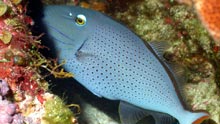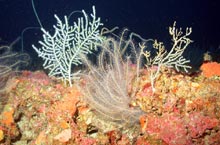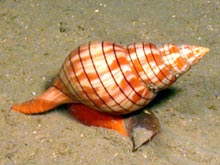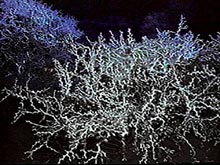
The deep-water coral Lophelia pertusa is found in large clusters, such as is shown here, at some sites in the Gulf of Mexico. Click image for larger view.
Mission Plan: “Gulf of Mexico Deep Sea Habitats”
University of Alabama, Dauphin Island Sea Lab
University of Oregon
Texas A&M University
The occurrence and ecology of deep water corals and associated communities in the Gulf of Mexico
The presence of deep-water corals in the Gulf of Mexico (GOM) has been known for several decades, yet little work has been focused on understanding their basic biology and functional ecology. Our current knowledge of the distribution of corals in the GOM is limited to sporadic reports of coral observations and sample collections, which indicate that deep-water coral colonies are likely widely distributed. We have no impression, however, of the abundance and extent of deep-water coral systems. Additionally, we do not know whether the distribution of deep-water corals in the GOM is linked to local hydrocarbon seepage or is present simply because hard substrate is produced and is often available where seepage occurs. In light of increasing anthropogenic activity in the GOM, there is an urgent need to understand these fragile and potentially valuable resources, and ultimately to determine appropriate management strategies for their protection.
This scientific endeavor is part of the first phase of an interdisciplinary, multi-institutional research collaboration. The primary objectives are highly exploratory in nature. Remotely operated vehicles will be used to investigate the presence and extent of deep-water corals and their correlation to geologic features at up to 8 sites. Additional information will be collected at each site to address questions associated with the functional ecology of the corals (e.g., associated fauna, hydrocarbon seepage, and microbial activity).
Our primary objectives are:
- Determine whether deep-water ahermatypic (lacking associated algae) corals are present at selected sites in the northern GoM.
- Assess the community of organisms that are living on the ocean floor at each site. For example, determine if corals are present as a component of a mixed species community, as single colonies, as a fully developed coral reef system, as dead structure, or are absent.
- Characterize the colony size, percent living vs. dead corals, and spatial distribution patterns of coral colonies encountered at each site.
- Characterize the geology (e.g., substrate type, topography) and hydrography (e.g., prevailing current, water temperature) of each site. If the presence of corals correlates strongly with certain geological or hydrographic features, it may be possible to predict coral distribution from data collected at the ocean’s surface.
- Collect ‘ground-truthing’ data of the ocean floor topography to verify and fine-tune previously collected sonographs.
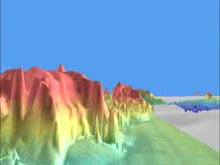
![]() A virtual fly-through of the Northwestern Gulf Of Mexico 2003 dive sites produced by Peter Etnoyer, MCBI. Click image to view video (Quicktime, 1 Mb).
A virtual fly-through of the Northwestern Gulf Of Mexico 2003 dive sites produced by Peter Etnoyer, MCBI. Click image to view video (Quicktime, 1 Mb).
Our secondary objectives include:
- Collect and identify organisms (e.g., crabs, brittlestars) associated with living and dead colonies of two deep-water corals (Lophelia and Madrepora).
- Deploy a time-lapse camera at one site with confirmed coral presence to observe the community of organisms living around the corals, especially commercially important species.
- Deploy an acoustic doppler current meter at the same site to document near-bottom current and temperature fields at the site.
- Analyze coral growth rates, age and/or food resources via isotopic signatures, and reproductive status.
- Examine the genetic relatedness of corals collected at each of the sites (Lophelia and Madrepora).
- Characterize the microorganisms that are associated with both living and dead Lophelia and Madrepora corals.
- Investigate the role of hydrocarbon/gas hydrate and associated fluid seepage in regard to continued or past precipitation of authigenic carbonate (precipitated by chemical or biochemical processes in the water), which forms the surrounding substrate, and the occurrence and distribution of deep-water corals on this substrate.
- Compare results obtained from sites where corals have colonized natural (e.g., authigenic carbonate) versus artificial substrates (e.g., shipwrecks).
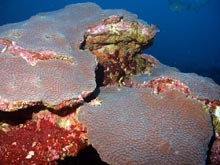
Once analyzed, the information collected during the expedition will help scientists understand the spatial distribution and connectivity of hard bottom reef communities associated with the targeted topographic features. Shown here – great star coral (Montastraea cavernosa). Click image for larger view.
Flower Garden Banks National Marine Sanctuary
Biological and Geological Characterization - Northwestern Gulf of Mexico
Scientists from NOAA’s Flower Garden Banks National Marine Sanctuary, Texas A&M University, NOAA’s National Marine Fisheries Service, University of Louisiana at Lafayette, and U.S. Geological Survey will use a remotely operated vehicle (ROV) to explore deep reef fish and coral communities between 50 and 200 meters deep. Biological and geological samples will be collected and high resolution digital still and video imaging will be used to characterize the study sites. The team will visit six different topographic features: Alderdice, Sonnier, Geyer, Bright, McGrail, and West Flower Garden Banks. The selected sites have been identified as biological communities warranting protection by the Minerals Management Service from oil and gas activities and serve as crucial spawning sites for commercially and recreationally important fishes and reef-building corals (East and West Flower Garden Banks).
Biological habitat maps are being developed for each bank by combining fish, invertebrate and benthic (bottom sediment) population inventories. The surface geology will be described and combined with biological data to describe the extent of hard bottom reef communities occurring within and around each of the targeted banks. The analyzed data will provide a comprehensive understanding of the spatial distribution and connectivity of deepwater coral reefs on each bank. Ultimately, the information will be included into Geographic Information System projects along with future and historic data to provide a powerful tool for making resource management decisions.
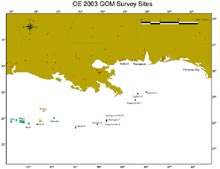
Outer continental shelf banks in the northwestern Gulf of Mexico where remotely operated vehicle (ROV) surveys will be conducted. Survey activities will include video transects, digital still photographs, and collection of voucher specimens. Click image for larger view.
The Science Party
This diverse group of explorers will include a scientific complement from the NOAA Flower Garden Banks National Marine Sanctuary, the University of Alabama, the University of Oregon, Texas A&M University, USGS, and the Marine Conservation Biology Institute, as well as several educators from various institutions. There will be two discrete scientific groups with several collaborating scientists examining various aspects of the deep sea coral communities in the GoM.
The team will be aboard the NOAA research vessel Ronald H. Brown and will use a remotely operated vehicle (ROV) from Sonsub Inc. ![]() , with positioning by C&C Technologies
, with positioning by C&C Technologies ![]() .
.






















